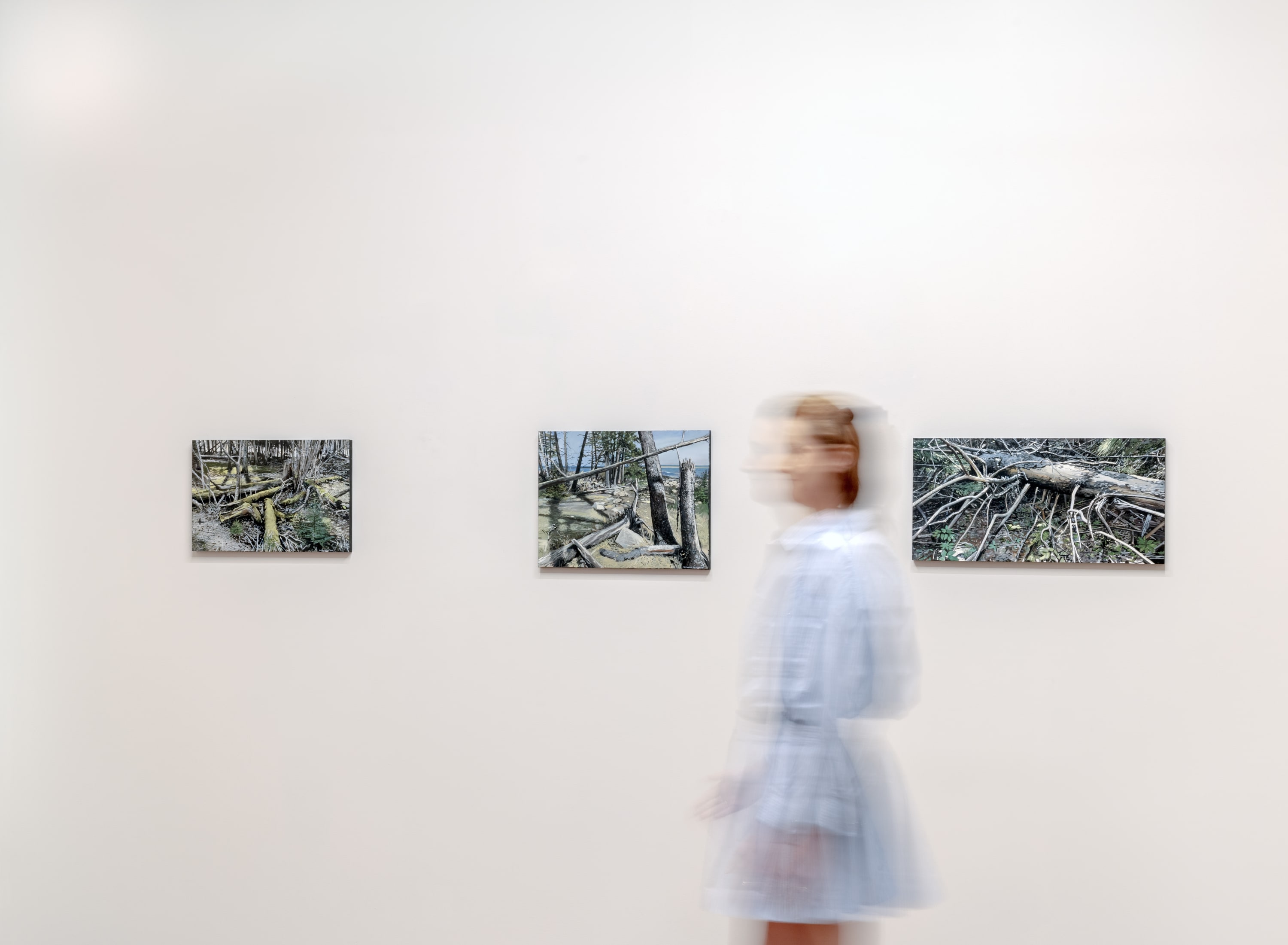A protected gem along the rugged coastline of Maine, Acadia National Park has long served as a sanctuary for nature enthusiasts and artists seeking inspiration from its dramatic landscapes. Although the park was established in 1916, the area around Mount Desert Island and Cadillac Mountain enjoyed a long and rich history, from its first inhabitants—the Wabanaki Native American peoples—through the Rusticator era, when artists of the Hudson River School inspired a new wave of tourism. The park encompasses nearly 50,000 acres of pristine wilderness, featuring granite peaks, mountain lakes, and sweeping ocean vistas that have captivated visitors for generations. The artistic legacy of the region runs deep, with American painters historically drawn to capture the rugged majesty of Maine's coastal wilderness. Artists like Sanford Robinson Gifford (see The Artist Sketching at Mount Desert, Maine, 1864-65; The National Gallery of Art, Washington, D.C.) and Frederic Church (see Twilight: Mount Desert Island, Maine,1865; Kemper Art Museum, Washington University in St. Louis), among many others, found in Acadia's landscapes a distinctly American sublime—raw, powerful, and emotive.
Among the contemporary artists who have found inspiration in Maine's coastal wilderness is Richard Estes, a painter primarily celebrated for his hyperrealistic depictions of New York City's urban landscapes. Known for his meticulous renderings of storefronts, reflective surfaces, and street scenes, Estes might seem an unlikely candidate to turn his artistic attention to the natural landscape. However, his connection to Maine runs strong after having been Introduced to the state in the 1970s through an invitation from his art dealer, Alan Stone. Estes was immediately drawn to the region's unique character, eventually purchasing the former home of artist and collector Carroll Sargent Tyson in Northeast Harbor and establishing a pattern that would define the rest of his career—splitting time between the frenetic energy of Manhattan's Upper West Side and the contemplative quietude of Maine.
A voracious traveler, Estes has voyaged and painted the far reaches of the globe, from the glaciers of Antarctica to the plains of Africa and the patrimonies of Europe.[1] Yet the geographical duality of New York and Maine has profoundly influenced his artistic development, allowing him to explore themes of complexity and perception across a variety of environments. In 2020, isolated in Maine during a period of unprecedented global uncertainty, Estes found himself drawn once again to compositions he had initially investigated several years earlier (see Acadia Park I, 2006; Crystal Bridges Museum of Art, Bentonville Arkansas). The resulting body of work—his previously unexhibited Acadia Park series—reveals an artist willing to challenge his skills and his audience's expectations.
-

-
The subject at the heart of the series is deliberately unconventional. Rather than focusing on the park's most celebrated vistas—the panoramic ocean views from Cadillac Mountain or the dramatic granite cliffs that define Maine's coastline—Estes directed his paintbrush to what many visitors might overlook as the park's less photogenic aspects. His paintings center on networks of fallen trees and forest floors, their intricate branches creating complex webs of organic geometry. These are scenes a hiker encounters in the midst of their journey, not the rewarding summit views that typically serve as final destinations and subjects of oil paintings. This choice was entirely intentional as Estes also paints the iconic views of Acadia and Mount Desert Island, making his focus on these interior forest scenes particularly notable (See View from Cadillac Mountain, 2020).
What drew Estes to these often-overlooked subjects becomes clear when examining the paintings themselves. The fallen trees and their elaborate branch systems present compositional challenges not unlike those found in his most celebrated urban paintings. The tangled complexity of organic forms mirrors the intricate networks of building facades, signage, a reflective surface that characterize his New York cityscapes (see Crosstown Bus in comparison to Acadia Park III). In both environments, Estes works through visual puzzles that demand his brand of photorealism and offer viewers multiple layers of visual information to decode.
The concept of artistic series or sequences has a rich history in modern art, from Claude Monet’s systematic exploration of haystacks under varying atmospheric conditions to John Marin’s dynamic interpretations of the industrial Weehawken waterfront. Monet used his serial approach to investigate how temporal changes and atmospheric effects alter the perception of light and color on his subjects, while Marin sought to distill the essential forms of the industrial landscape into increasingly abstract color and gestural notations. (See Weehawken Sequence examples). Both artists worked primarily from direct observation, responding to the immediate visual experience of their subject.
-

-
Estes' methodology differs significantly from these precedents, as his meticulous approach has always been grounded in his own photography practice, which he constructs into intricate compositions in his studio and translates into paintings. This process allows him to achieve levels of detail, precision, and composite views that would be impossible through direct observation alone. Perhaps what prompted Estes to create this particular group of paintings was the unique challenge these forest landscapes presented to his established working methods. While many a talented painter could capture the essential beauty of Acadia National Park through more traditional approaches, only an artist with Estes' hyperrealist style and masterful execution could successfully realize these intimately scaled yet incredibly complex compositions. The resulting paintings function almost like scientific specimens or microscope slides. Viewed from a typical viewing distance of several feet, the paintings clearly depict sections of fallen tree stumps and branches, yet Estes invites close examination to witness what lies beneath the surface. With one's face mere inches from the painted surface, individual sections reveal themselves to be highly abstract compositions, the brushwork mirroring the frenetic limbs of the flora they depict (see close-up of Acadia Park VII).
At first consideration, this series might seem like an unexpected departure for a painter renowned for his large-scale, dramatic urban landscapes. However, these Acadia Park works reveal, through their visual complexity, a deep-rooted interest for the artist. Whether depicting the man-made environment of New York City or the natural wilderness of Maine, Estes finds equal measures of visual intrigue in both the forest floor and the city street, and he consistently gravitates toward the creation of intricate compositions that challenge both painter and viewer to question what we see and how we perceive it, inviting us to look carefully at the visual world around us.
-
Richard Estes on his camera as a sketchbook.
-

-
 Richard Estes in Maine.
Richard Estes in Maine. -
If you would enjoy learning more about the available works, please contact Alana Ricca at (212) 879-8815, or alana@schoelkopfgallery.com. We look forward to being in touch.










